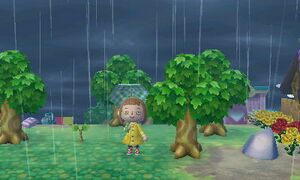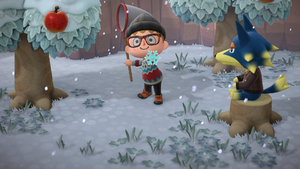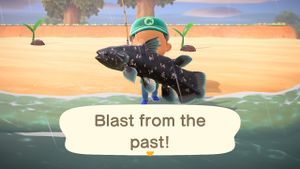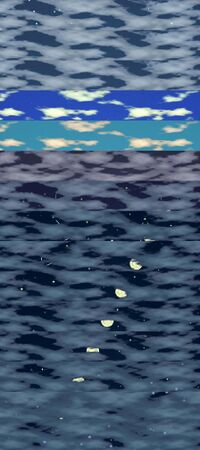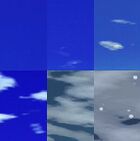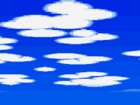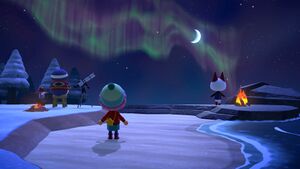Weather
Weather plays a part in the Animal Crossing series, changing daily and reflecting the seasons. Notable weather changes include winter snowstorms, late summer rainstorms and the clear skies of early summer. Weather is mentioned by villagers, influenced by the flora and fauna in the player's town, and, most importantly, reflected by the seasons and the time of year, greatly enhancing gameplay.
Weather consists of two main features: precipitation and cloud coverage. These aspects are present constantly, whilst other, more unusual features add to the variation of the game.
Precipitation[edit]
Precipitation comes in two forms in the Animal Crossing series: rain and snow. Snow falls only in the winter months, with rain occurring during the rest of the year, though more often during spring and the late summer rainy season. Precipitation can change from hour to hour, but will often last for much of the day, easing off as the day progresses.
Rain[edit]
Rain falls throughout the year, in all four seasons. Rain, like snow, waters wilted plants without the need for a watering can. Rainy weather switches the hourly music to variants with a light ringing noise, in Animal Crossing, only one tune plays during rainy weather, no matter the hour. Villagers who are outside when rain is falling carry umbrellas and might also comment on the weather. Frog villagers, however, do not carry umbrellas since they are amphibious. After a rainy day, it is common to find Gyroids around the player's town. Villagers may also comment on the weather. In New Horizons, villagers may wear rain clothes and hat instead of holding an umbrella.
In City Folk, rain can be heard falling on the roofs of homes when inside them.
If it is raining in the city in City Folk, the town will also be affected by this rain, even if it is a clear day – plants will be automatically hydrated and Gyroids can be found underground the next day. This only works if the player returns from the city after visiting it in the rain, and will not work if they simply save the game and quit when in the city.
Thunderstorms[edit]
Occasionally, thunderstorms can occur during rainy days. On rare occasions, lightning can be seen. Thunderstorms are purely cosmetic and otherwise act identical to normal rain.
Snow[edit]
Snow falls from mid-to-late November until early-to-late February (or late May until late-August in the southern hemisphere in Animal Crossing: New Horizons), settling in early December, with complete coverage by the 11th of December (10th in Animal Crossing and the 11th of June in the southern hemisphere in New Horizons). Settled snow covers all grassy areas, buildings and trees. Snowballs appear around town every day in winter, and can be rolled into Snow People. Additionally, in New Leaf and New Horizons, snowflakes will fly around town and can be caught with a net. When snowing, hourly music is altered slightly to sound more like the rain variants but with sleigh bell sounds integrated into them as well. Like rain, snow hydrates wilted flowers without the need for a watering can. Villagers who are outside during winter may talk about the abundance of snow or the cold.
On the 10th of December (or the 10th of June in a Southern Hemisphere island in New Horizons), heavy snowfall can be sighted, leading to snow sticking to the ground the next day. Due to a bug in Animal Crossing: New Leaf, on certain calendar patterns where the 10th falls on a Saturday, it will not snow due to it conflicting with the Fishing Tourney.
- Winter – Rain falls very infrequently in late winter.
- Spring – Moderate rainfall occurs in the spring. Thunderstorms can occur, but it is rare.
- Summer – Summer has a great contrast in rain levels; mid and late summer is completely dry, with clear skies and no rain. Early summer consists of heavy thunderstorms and rainy weather spanning days.
- Fall – Low to moderate levels of rainfall occur in fall. Thunderstorms taper off after the end of September.
Effect on wildlife[edit]
Rain and snow influence the presence of insects and fish.
Fish[edit]
One fish, the rare Coelacanth, appears only when it is raining or snowing (snow does not count in Doubutsu no Mori+, Animal Crossing, Doubutsu no Mori e+, or Animal Crossing: New Horizons). This unusual behavior makes it even harder to catch.
Bugs[edit]
Rain and snow prevents butterflies (prior to Animal Crossing: New Horizons), many varieties of beetles, the Scorpion, and the Tarantula (with the exception in New Horizons for the latter two) from appearing even when they are in-season. However, some bugs only appear when it rains, such as the Snail. Cicadas can still be found when it is raining, but they make no noise. Catch quotes for cicadas in New Leaf and New Horizons are also different when caught in the rain.
The Dung Beetle is the only bug that is dependent on snow to exist – it appears exclusively when snow is on the ground, the reason being that it can be found rolling around snowballs on the ground.
Cloud coverage[edit]
There are many different levels of cloud coverage. These levels can potentially change every hour, and range from clear to complete. In the original Animal Crossing, the layout of the game ensured that the sky was only visible on one occasion, on the train, where it was always cloudy. This means that the paragraphs about cloud coverage only apply to games following Animal Crossing. Cloud coverage changes abruptly in Wild World, but in City Folk changes gradually in the last ten minutes before the hour.
Clouds always travel from the north of the town towards the sea, somewhat contradicting the fluttering of the town flag and the floating pattern of balloons. Clouds appear white in the day, unless rain bearing, upon which they are gray. Clouds at night are a darker shade of gray. Cloud coverage gives an indication as to what the weather will be like in the coming hours. Dark, thick clouds usually signify rain, whereas light cloud usually means that the skies will be clear later on.
Clouds in Wild World consist entirely of oval-shapes, and are bright white. They can be viewed on the upper screen of the Nintendo DS. Clouds in City Folk are less regular in shape and color, and so appear more varied. They can be viewed on the horizon or by pressing the 'up' button on the Wii remote. This rolls the screen up so that the sky dominates the view.
There are six varieties of cloud coverage, which affect various, minor aspects of gameplay. For example, the brightness of a room, whether lights are on or not, and the comments of villagers. Here is a list and brief description of the six cloud densities.
- Clear: No clouds in the sky. The sky appears bright blue, or at night, full of stars.
- Contrail: A single or two line-shaped clouds that trails across the sky. It can occasionally be seen with other types of clouds, or by itself. This cloud is artificial, as it is only produced by aircraft.
- Wisp: Similar to clear, but with faint, infrequent specks of white cloud trailing across the sky.
- Light: Noticeable clouds in the sky, dispersed but still frequent.
- Moderate: Substantial cloud cover, lowered level of brightness.
- Dense: Packed clouds with gaps in coverage. Low level of brightness and lowered visibility.
- Complete (1): Heavy and steel gray with only small breaks in cloud. Always bearing rain. Low visibility, horizon appears dull and foggy.
- Complete (2): During a thunderstorm, or when snow is falling, the clouds will have even less breaks in them. Low visibility, horizon appears dull and foggy.
Weather warnings[edit]
At the start of each new major weather system, a note is left on the bulletin board to inform the player of its imminent arrival.
- Snow Warning – Two days before snow settles on the ground, a notice appears to notify the player. The notice appears in early December.
- New Year Weather – A bulletin containing information on the following month's snow levels, temperature and the possibility of ponds freezing over. The notice is posted in mid-January.
- Summer Forecast – Headed as 'Weather Forecast', this notice appears on the first Wednesday of May. It reveals the summer forecast, stating when the rainy season will start, and when the temperature should start to pick up.
- Meteor Shower – Although not a weather system, this note appears before a meteor shower labeled as a 'Weather Warning'. Meteor showers arrive at random times in the year, starting at 7 PM and lasting well into the night. These do not appear in Wild World.
In addition, weather can be forecasted, providing a short-term summary of the overall conditions of the following day. If the player turns on a television, it will, at certain times of the day, display the weather, using symbols such as a sun, cloud or raindrop. This forecast is always correct, but is limited to generalizing the next day's weather. It cannot, therefore, give hourly predictions.
In Animal Crossing: New Leaf, the instrument shelter, a public works project, can inform the player of the next hour's weather.
Other features[edit]
- On nights where the sky is clear, meteor showers can occur. The shooting stars can be wished upon by pressing the 'A' button when it flashes through the sky. It is only possible to do this when holding no items. In games prior to New Horizons, this will result in a present being mailed to the player, containing a spotlight item. In New Horizons, star fragments will appear on the beach the next day.
- Rainbows can be seen very occasionally in the sky, as they only appear when the sky has cleared suddenly after many hours of heavy rain or snowfall. The rainbow fills the sky, brightening as the hour progresses, until it peaks after thirty minutes. Within the hour, it disappears. During a rainbow, the chances of finding 100 Bells in trees is increased. They appear towards the end of the day, but not at night. In New Leaf and New Horizons it is possible to see a double rainbow. An error in the coding of weather patterns makes it impossible to see a rainbow from October 1 to December 15 in the southern hemisphere in New Horizons. In the first-generation games, rainbows appear above the waterfall on clear mornings if precipitation fell the day before.
- In both Wild World and City Folk, the sky clears when a fireworks show is due to take place. Meteors only appear on clear nights as well, and are accompanied by a twinkling noise. In New Leaf, it will be sunny the whole day when the Fireworks show is set to take place.
- In the city area in City Folk, the weather is often different from that in the player's town. Snow does not settle in the city, but does on the bus that drives to and from it. If it is raining in the city, the animals there will carry umbrellas.
- Confetti falls continuously from the sky during the Festivale in City Folk and New Leaf. On this day, the sky tends to be very clear, as any snowfall would conflict with the fall of confetti.
- In early April (or early October in the southern hemisphere), trees will grow cherry blossoms, and those cherry blossoms will float through the sky, much like confetti does during Festivale (see above). The sky is clear on these days. In New Horizons, they can be caught with a net and used for DIY recipes.
Aurora[edit]
The aurora, also known as the northern lights,[1] is a natural phenomenon that occurs in the night sky in the Animal Crossing series beginning in Animal Crossing: City Folk.
In Animal Crossing: City Folk and Animal Crossing: New Leaf, the aurora is visible on clear winter nights, and can be seen from 8 PM until 10 PM. It is at its brightest at 9 PM, shining bright shades of pink and green and moving constantly in a folding motion. In Animal Crossing: New Horizons, it can appear in any hour with clear conditions between 7 PM and 4 AM, as long as there are no shooting stars that night.
Residents of the player's town may comment on the aurora when it is in the sky. It can be seen in full by adjusting the camera angle while outdoors, enabling the player to get a full view of the sky.
Patterns[edit]
In Animal Crossing: New Horizons[edit]
There are currently 40 possible weather patterns in New Horizons, six of which had been added in updates.[2][3]
| Key | |
|---|---|
| F | Fine, clear weather |
| S | Fair, mildly cloudy weather |
| C | Average, cloudy weather |
| RC | Heavy, cloudy weather |
| R | Rainy/snowy weather |
| HR | Heavy, rainy/snowy weather |
| Weather patterns | Weather | |||||||||||||||||||||||
|---|---|---|---|---|---|---|---|---|---|---|---|---|---|---|---|---|---|---|---|---|---|---|---|---|
| 5AM | 6AM | 7AM | 8AM | 9AM | 10AM | 11AM | 12PM | 1PM | 2PM | 3PM | 4PM | 5PM | 6PM | 7PM | 8PM | 9PM | 10PM | 11PM | 12AM | 1AM | 2AM | 3AM | 4AM | |
| Fine00[nb 1] | F | S | F | S | F | S | S | F | S | F | S | S | F | S | F | F | F | S | F | F | F | S | S | F |
| Fine01[nb 2] | S | F | S | S | S | F | S | C | F | S | F | S | S | C | S | C | S | F[nb 3] | S | F[nb 3] | F[nb 3] | S | F[nb 3] | F |
| Fine02[nb 4][nb 5] | S | S | F | S | F | C | F | S | F | S | S | F | S | C | S | S | S | F | F | F | F | S | S | S |
| Fine03[nb 2] | S | S | F | S | S | F | S | S | C | S | F | S | S | S | F[nb 3] | C | F[nb 3] | F[nb 3] | S | F[nb 3] | S | F[nb 3] | F[nb 3] | F |
| Fine04[nb 4] | S | S | S | S | C | S | S | F | S | C | S | F | S | F | S | S | F | S | F | F | F | F | S | S |
| Fine05[nb 2] | S | S | S | F | S | S | F | S | S | C | S | S | F | S | C | S | S | F[nb 3] | S | C | S | S | F[nb 3] | S |
| Fine06[nb 4][nb 6] | S | C | S | S | C | F | S | F | S | S | F | S | C | C | S | S | S | F | F | F | S | F | S | S |
| Fine07[nb 7][nb 8][nb 9] | F | S | F | S | F | S | S | F | S | F | S | S | F | S | F | S | S | S | C | F | S | F | S | C |
| Fine08[nb 10] | F | F | F | F | F | F | F | F | F | F | F | F | F | F | F | F | F | F | F | F | F | F | F | F |
| Fine09[nb 10] | F | F | F | F | F | F | F | F | F | F | F | F | F | F | F | F | F | F | F | F | F | F | F | F |
| Cloud00 | C | RC | C | C | C | S | S | C | C | C | S | S | C | C | C | RC | C | C | S | S | S | S | C | C |
| Cloud01 | C | C | C | S | C | RC | C | C | S | C | C | C | RC | RC | C | C | S | S | S | S | C | RC | C | C |
| Cloud02 | C | C | RC | R | R | R | C | C | RC | R | R | R | C | C | RC | C | RC | C | C | C | C | C | RC | C |
| Rain00 | R | R | RC | C | S | RC | R | R | R | R | R | R | C | C | RC | R | R | R | C | S | C | RC | R | R |
| Rain01 | R | R | R | R | C | RC | R | R | C | C | RC | HR | R | R | R | R | S | S | C | RC | R | R | R | R |
| Rain02 | R | R | R | RC | R | S | RC | R | R | R | C | R | R | R | RC | HR | R | R | R | RC | C | R | R | R |
| Rain03 | R | RC | R | R | HR | HR | R | R | HR | HR | HR | HR | R | R | R | R | R | C | RC | R | R | R | R | R |
| Rain04 | R | R | HR | HR | HR | HR | R | HR | HR | HR | R | R | HR | HR | HR | HR | HR | HR | R | R | R | HR | HR | R |
| Rain05 | HR | HR | R | R | HR | HR | HR | HR | R | HR | HR | HR | HR | HR | HR | R | R | C | S | RC | R | R | HR | R |
| Rain06[nb 8] | HR | HR | HR | HR | HR | HR | HR | HR | HR | HR | HR | HR | HR | HR | HR | HR | HR | HR | HR | HR | HR | HR | HR | HR |
| Rain07[nb 7][nb 8][nb 11] | R | HR | C | C | R | HR | HR | R | HR | RC | R | HR | R | R | HR | RC | HR | R | RC | C | R | HR | R | RC |
| FineCloud00 | R | C | C | C | C | C | S | S | F | S | S | F | S | S | S | C | C | C | C | RC | C | RC | RC | C |
| FineCloud01 | C | S | S | S | F | S | S | F | S | S | C | RC | R | R | C | C | RC | C | C | C | RC | C | C | C |
| FineCloud02 | C | F | S | F | S | S | C | C | S | C | C | C | C | C | RC | C | RC | RC | R | R | R | C | C | C |
| CloudFine00[nb 12] | RC | R | R | C | R | S[nb 13] | C | S | C | C | S | S | F | S | S | S | S | F | F | F | S | S | S | S |
| CloudFine01[nb 12] | S | R | C | C | C | C | RC | R | S[nb 13] | S | C | S | S | F | S | F | F | S | F | S | S | S | S | S |
| CloudFine02[nb 12] | F | C | RC | R | C | RC | R | S[nb 13] | S | S | S | F | S | F | S | F | F | S | F | S | S | S | S | S |
| FineRain00[nb 12] | S | S | F | S | F | S | F | S | R | S[nb 13] | S | S | S | S | F | S | F | S | S | F | F | S | S | S |
| FineRain01[nb 12] | S | F | S | S | F | S | S | R | C | R | S[nb 13] | S | S | F | S | S | S | S | S | F | S | F | S | S |
| FineRain02 | F | F | S | F | S | F | S | F | S | S | HR | C | S | F | S | S | F | S | F | S | F | F | S | S |
| FineRain03[nb 12] | S | S | S | F | S | F | F | S | S | HR | R | S[nb 13] | S | S | F | S | S | F | S | F | F | S | F | S |
| CloudRain00 | R | C | C | S | C | C | RC | R | R | R | HR | HR | R | R | R | R | R | R | R | R | R | R | R | R |
| CloudRain01 | C | S | S | C | C | R | R | R | C | C | RC | R | R | R | R | R | C | R | R | R | R | R | R | C |
| CloudRain02 | R | C | C | C | S | S | C | C | RC | R | R | R | R | R | R | R | R | R | RC | HR | HR | R | HR | R |
| RainCloud00 | C | R | R | C | C | RC | R | R | C | RC | C | S | S | C | C | C | C | C | C | C | RC | C | C | C |
| RainCloud01 | RC | R | R | R | R | R | R | R | R | R | C | RC | C | C | C | C | C | S | S | C | C | C | C | C |
| RainCloud02 | RC | HR | HR | R | R | R | C | C | R | C | C | C | C | C | RC | C | RC | C | C | S | S | C | C | RC |
| Commun00[nb 14] | S | F | S | S | S | F | S | C | F | S | F | S | S | C | S | C | S | F | S | F | F | S | F | F |
| EventDay00[nb 15] | S | F | S | S | S | F | S | S | F | S | F | S | S | F | S | F | S | F | S | F | F | S | F | F |
| EventDay01[nb 16][nb 17] | C | S | F | S | F | S | S | F | S | S | C | S | C | RC | RC | C | RC | RC | C | RC | RC | RC | RC | C |
| EventDay02[nb 18][nb 19] | R | R | R | R | R | R | R | R | R | R | R | R | HR | HR | R | HR | HR | HR | R | HR | HR | HR | R | HR |
| EventDay03[nb 20][nb 19] | R | HR | R | HR | R | HR | R | RC | HR | R | HR | C | S | C | F | S | F | S | C | F | S | C | S | C |
Appearances[edit]
Below are tables showing the chance of certain types of weather throughout the year in each game.
In Animal Crossing[edit]
| Dates | Rain | Thunderstorm | Snow | Heavy snow |
|---|---|---|---|---|
| Jan 1 – 7 | 0% | 0% | 0% | 0% |
| Jan 8 – Feb 24 | 0% | 0% | 20% | 10% |
| Feb 25 – Mar 31 | 20% | 0% | 0% | 0% |
| Apr 1 – 8 | 0% | 0% | 0% | 0% |
| Apr 9 – 19 | 20% | 0% | 0% | 0% |
| Apr 20 | 0% | 0% | 0% | 0% |
| Apr 21 – Jun 25 | 20% | 10% | 0% | 0% |
| Jun 26 – Jul 3 | 30% | 20% | 0% | 0% |
| Jul 4 | 0% | 0% | 0% | 0% |
| Jul 5 – Jul 15 | 30% | 20% | 0% | 0% |
| Jul 16 – Aug 11 | 0% | 10% | 0% | 0% |
| Aug 12 | 0% | 0% | 0% | 0% |
| Aug 13 – Aug 31 | 0% | 10% | 0% | 0% |
| Sep 1 – 30 | 0% | 40% | 0% | 0% |
| Oct 1 – 30 | 20% | 0% | 0% | 0% |
| Oct 31 | 0% | 0% | 0% | 0% |
| Nov 1 – 15 | 10% | 0% | 10% | 0% |
| Nov 16 – Dec 9 | 0% | 0% | 30% | 0% |
| Dec 10 | 0% | 0% | 0% | 100% |
| Dec 11 – 24 | 0% | 0% | 40% | 20% |
| Dec 25 – 30 | 0% | 0% | 60% | 40% |
| Dec 31 | 0% | 0% | 0% | 0% |
In Animal Crossing: New Horizons[edit]
Northern hemisphere[edit]
| Dates | Rain | Heavy rain | Snow | Heavy snow |
|---|---|---|---|---|
| Jan 1 – 4 | 0% | 0% | 0% | 0% |
| Jan 5 – Feb 23 | 0% | 0% | 22% | 21% |
| Feb 24 | 0% | 0% | 30% | 0% |
| Feb 25 – Mar 31 | 24% | 12% | 0% | 0% |
| Apr 1 – 10 | 0% | 0% | 0% | 0% |
| Apr 11 – Jun 15 | 25% | 14% | 0% | 0% |
| Jun 16 – Jul 5 | 30% | 38% | 0% | 0% |
| Jul 6 – Jul 31 | 25% | 11% | 0% | 0% |
| Aug 1 – 31 | 13% | 20% | 0% | 0% |
| Sep 1 – 15 | 21% | 28% | 0% | 0% |
| Sep 16 – 30 | 23% | 13% | 0% | 0% |
| Oct 1 – Nov 15 | 26% | 7% | 0% | 0% |
| Nov 16 – Nov 25 | 0% | 0% | 0% | 0% |
| Nov 26 – Dec 9 | 0% | 0% | 24% | 12% |
| Dec 10 | 0% | 0% | 0% | 100% |
| Dec 11 – 23 | 0% | 0% | 28% | 28% |
| Dec 24 – 30 | 0% | 0% | 30% | 70% |
| Dec 31 | 0% | 0% | 0% | 0% |
Southern hemisphere[edit]
| Dates | Rain | Heavy rain | Snow | Heavy snow |
|---|---|---|---|---|
| Jan 1 – 4 | 0% | 0% | 0% | 0% |
| Jan 5 – 31 | 25% | 11% | 0% | 0% |
| Feb 1 – 28/29 | 18% | 15% | 0% | 0% |
| Mar 1 – 15 | 21% | 24% | 0% | 0% |
| Mar 16 – 31 | 23% | 13% | 0% | 0% |
| Apr 1 – May 15 | 26% | 8% | 0% | 0% |
| May 16 – 24 | 12% | 0% | 0% | 0% |
| May 25 | 30% | 0% | 0% | 0% |
| May 26 – Jun 9 | 0% | 0% | 24% | 12% |
| Jun 10 | 0% | 0% | 0% | 100% |
| Jun 11 – 30 | 0% | 0% | 28% | 28% |
| Jul 1 – Aug 23 | 0% | 0% | 22% | 21% |
| Aug 24 | 0% | 0% | 30% | 0% |
| Aug 25 – Sep 30 | 24% | 12% | 0% | 0% |
| Oct 1 – 10 | 0% | 0% | 0% | 0% |
| Oct 11 – Dec 15 | 15% | 12% | 0% | 0% |
| Dec 15 – 30 | 25% | 14% | 0% | 0% |
| Dec 31 | 0% | 0% | 0% | 0% |
Gallery[edit]
First-generation games[edit]
Animal Crossing: Wild World[edit]
Animal Crossing: City Folk[edit]
Animal Crossing: New Leaf[edit]
Animal Crossing: New Horizons[edit]
Notes[edit]
- ↑ Heavy meteor shower pattern from 7PM – 4AM
- ↑ 2.0 2.1 2.2 Aurora pattern (only in winter)
- ↑ 3.00 3.01 3.02 3.03 3.04 3.05 3.06 3.07 3.08 3.09 3.10 3.11 Aurora
- ↑ 4.0 4.1 4.2 Light meteor shower pattern from 7PM – 4AM
- ↑ Prior to version 1.3.0, 6PM was Sunny and 7PM was Cloudy
- ↑ Prior to version 1.3.0, 5PM was Sunny and 7PM was Cloudy
- ↑ 7.0 7.1 Used on the archipelago island.
- ↑ 8.0 8.1 8.2 Added in version 1.11.0
- ↑ Prior to version 2.0, 8PM, 10PM, 11PM and 4AM were Clear
- ↑ 10.0 10.1 Used on boat tours
- ↑ Prior to version 2.0, 5AM, 9AM, and 11PM were Rain Clouds, 6AM and 10PM were Cloudy, 1PM, 9PM, 12AM, 2AM, and 4AM were Rain, and 2PM, 3PM, and 8PM were Heavy Rain
- ↑ 12.0 12.1 12.2 12.3 12.4 12.5 Rainbow pattern (outside of winter)
- ↑ 13.0 13.1 13.2 13.3 13.4 13.5 Rainbow
- ↑ Used on Harv's Island
- ↑ Used on event days and on a resident's first day
- ↑ Used on Halloween
- ↑ Added in version 1.5.0
- ↑ Used on Toy Day if on the northern hemisphere
- ↑ 19.0 19.1 Added in version 1.6.0
- ↑ Used the next day after Toy Day if on the northern hemisphere
References[edit]
- ↑ Animal Crossing: New Leaf - Prima Official Game Guide, page 126.
- ↑ https://docs.google.com/spreadsheets/d/16VjCWO94jG_QexsBAjoKLntyfUF_e-B6WPRl8l-jM1o/edit#gid=1175395937
- ↑ 2.0.0 - Animal Crossing: New Horizons Datamine
| Gameplay elements | ||||||||||||||||||||||||||
|---|---|---|---|---|---|---|---|---|---|---|---|---|---|---|---|---|---|---|---|---|---|---|---|---|---|---|
| ||||||||||||||||||||||||||

